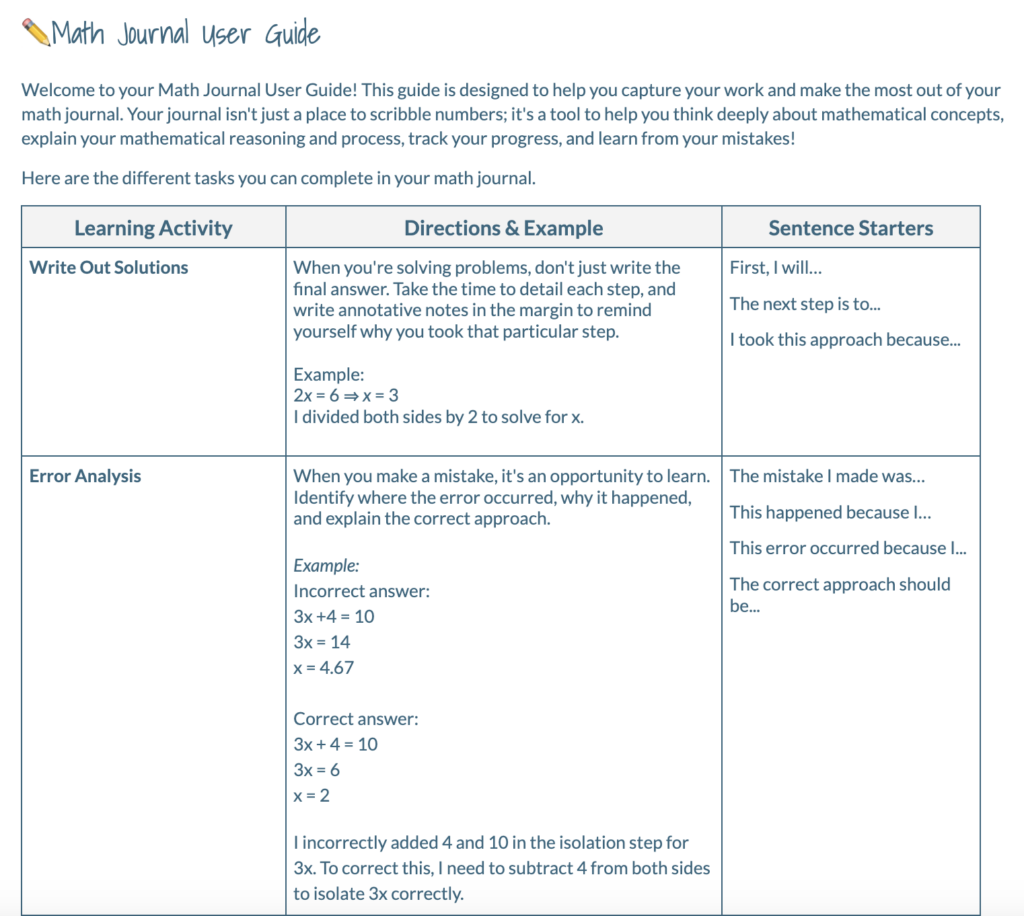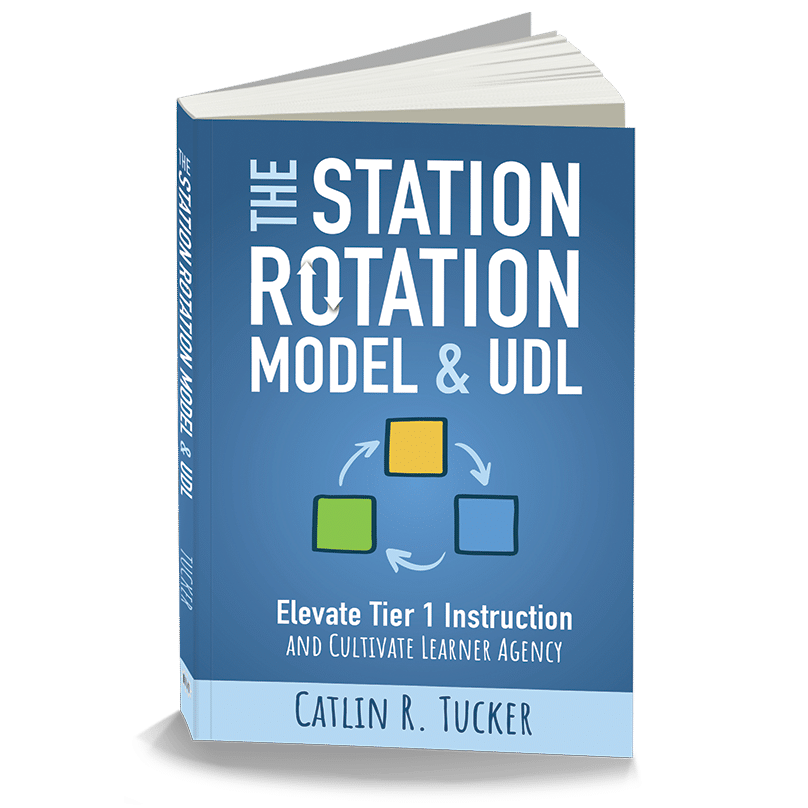In my last blog post, Using the Station Rotation Model in Math, I wrote about the benefits of shifting from a whole group, teacher-led lesson design to small-group differentiated instructional sessions. I make the case that the whole group, teacher-led approach to instruction limits opportunities for individual exploration and deep engagement with mathematical concepts. It restricts students’ ability to learn at their own pace, explore topics in-depth, and engage in hands-on, practical problem-solving.
Relying exclusively on a teacher-led, whole-group approach to instruction risks reducing math to a series of steps to follow rather than fostering a deeper understanding and appreciation of the subject. It also positions the teacher to do the lion’s share of the work and thinking in the classroom.
In this blog post, I want to focus on how math teachers can use a math journal at the offline station to encourage students to engage in a regular reflective practice and think more deeply about mathematical concepts and processes. My newest book, Shift Writing into the Classroom, Dr. Novak and I highlight the myriad benefits of writing across the curriculum and want to support all teachers in moving writing into the classroom, where it can deepen learning and help students develop as expert learners. Math is no different! Asking students to explain their mathematical reasoning and write about their process can help them to understand, retain, and apply their learning.
A question I often get from math teachers learning about the station rotation model is, “What are students doing at the other stations that are not teacher led?” In math class, the online station is frequently used to allow students to complete personalized practice with a math program, like IXL or ALEKS, or complete online activities on a site like Desmos. The offline station is used for spiral review and work with practice problems, usually in the form of worksheets. When coaching teachers, I encourage them to consider a math journal at that offline station. That suggestion is often met with some skepticism since writing isn’t necessarily a staple in most math classes, but I think it should be.
The Benefits of a Math Journal
Math teachers can use journals to encourage students to engage deeply with math concepts and processes. When math teachers ask students to document their reasoning and explain their mathematical thinking, it helps to reinforce their understanding, highlight areas of confusion or need, and document their growth over time. This ongoing documentation is an artifact that students can refer back to, reflecting on hurdles they’ve overcome and concepts they’ve mastered. Over time, this can foster a sense of accomplishment and a deeper understanding of mathematical concepts and processes.
Writing in math journals does not adhere to a strict format, which means students can freely express their ideas and concerns, focusing more on the content rather than worrying about the structure of their writing. This freedom can significantly reduce the mental load, allowing students to concentrate on understanding and applying mathematical concepts. Journaling also supports self-regulated learning because students are identifying areas where they struggle and strategies they can employ to overcome these challenges.
For teachers, the adoption of math journals can also lessen the burden of managing and grading piles of worksheets. Instead of having teachers collect stacks of student work to grade for accuracy, I’d like to put that responsibility on students. I want them to think critically about their work. Review and practice should be opportunities for students to learn from their mistakes. Students should not be penalized for having incorrect answers on assignments designed to prepare them for an assessment. That’s where a self-assessment practice can shift students’ understanding of the purpose of this work to appreciate how it is helping them to develop as math students.
An ongoing self-assessment practice can be documented in their math journals, allowing them to take notes on what they did well and identify the areas where they need to spend more time developing their understanding and honing their skills. Students can capture this documentation in a written journal entry or graphically display what they learned about themselves from each self-assessment. Building this self-assessment and reflective practice into a daily math journal can position students to lead the learning and identify areas where they would benefit from additional instruction, guided practice, or support.
Math Journal Activities
Teachers can provide students with various math prompts to support deep engagement with math concepts and encourage reflection and metacognitive skill building. Below is a list of activities and prompts teachers can use to guide students’ work in their math journals.
Write Out Solutions: When solving problems, don’t just write the final answer. Take the time to detail each step, and write annotative notes in the margin to remind yourself why you took that particular step. Explain what you did first, second, third, etc., and why.
Error Analysis: When you make a mistake, it’s an opportunity to learn. Identify where the error occurred, why it happened, and explain the correct approach.
Visual Aids: Draw graphs, figures, flowcharts, concept maps, or sketchnotes to visualize complex concepts and processes.
Learning Log: Write a summary or draw a representation of what you learned.
- What specific mathematical concept[s], processes, or skills did you learn?
- How did you learn these things? What activities, instruction, or support helped you to learn these things?
- What was challenging in the last week or unit?
- What questions or wonderings do you have?
- What do you need to spend more time on?
- What support would be helpful as you continue to work?
I’ve compiled a list of learning activities complete with directions, examples, and sentence starters in the math journal user guide I developed for students. You can access your copy of the math journal user guide below.
Math journals can also be used to provide students with meaningful choices in a math class. If they have a collection of prompts to choose from, they can decide how they want to document and reflect on their learning in their journals. So, teachers using the math journal as the foundation for an offline station in a station rotation can invite students to select the learning activity they want to engage with or ask them to focus on a particular activity.
Wrap-up
Integrating writing into math classes, especially through math journals, offers a unique way for students to deepen their understanding and engage more actively with mathematical concepts. This approach draws from the research that shows writing is a powerful tool for learning. It allows students to reflect on their thoughts and processes, which can help to bolster their understanding. Writing in math can help students externalize their problem-solving strategies, making their thinking visible not just to their teachers but to themselves as well. This process of writing down their reflections and problem-solving steps aids in organizing their thoughts and clarifying their understanding of complex concepts.
The Station Rotation Model and UDL: Elevate Tier I Instruction and Cultivate Learner Agency is available now! I’d love for you to check it out, share it with a colleague, and let me know what resonates most with you. If you have any questions about the book, please post a comment!
School leaders interested in using the book for a staff-wide study can place a discounted bulk order for 10 or more copies. If you and your teachers need additional support, I offer customized professional learning that is hands-on, practice-based, and tailored to your team’s needs. Together, we can support your teachers in developing their UDL practice, differentiating instruction more effectively, and elevating Tier 1 instruction. We can even utilize the Station Rotation Model to create space for Tier 2 support and Tier 3 intervention within general education classrooms. And, we can explore how this model can help us position students as active agents leading their learning!






2 Responses
Thank you so much for this wonderful insight into writing journals in math.
You’re welcome, Jana!